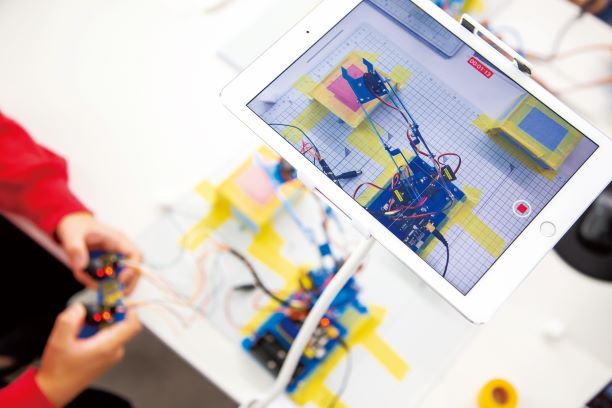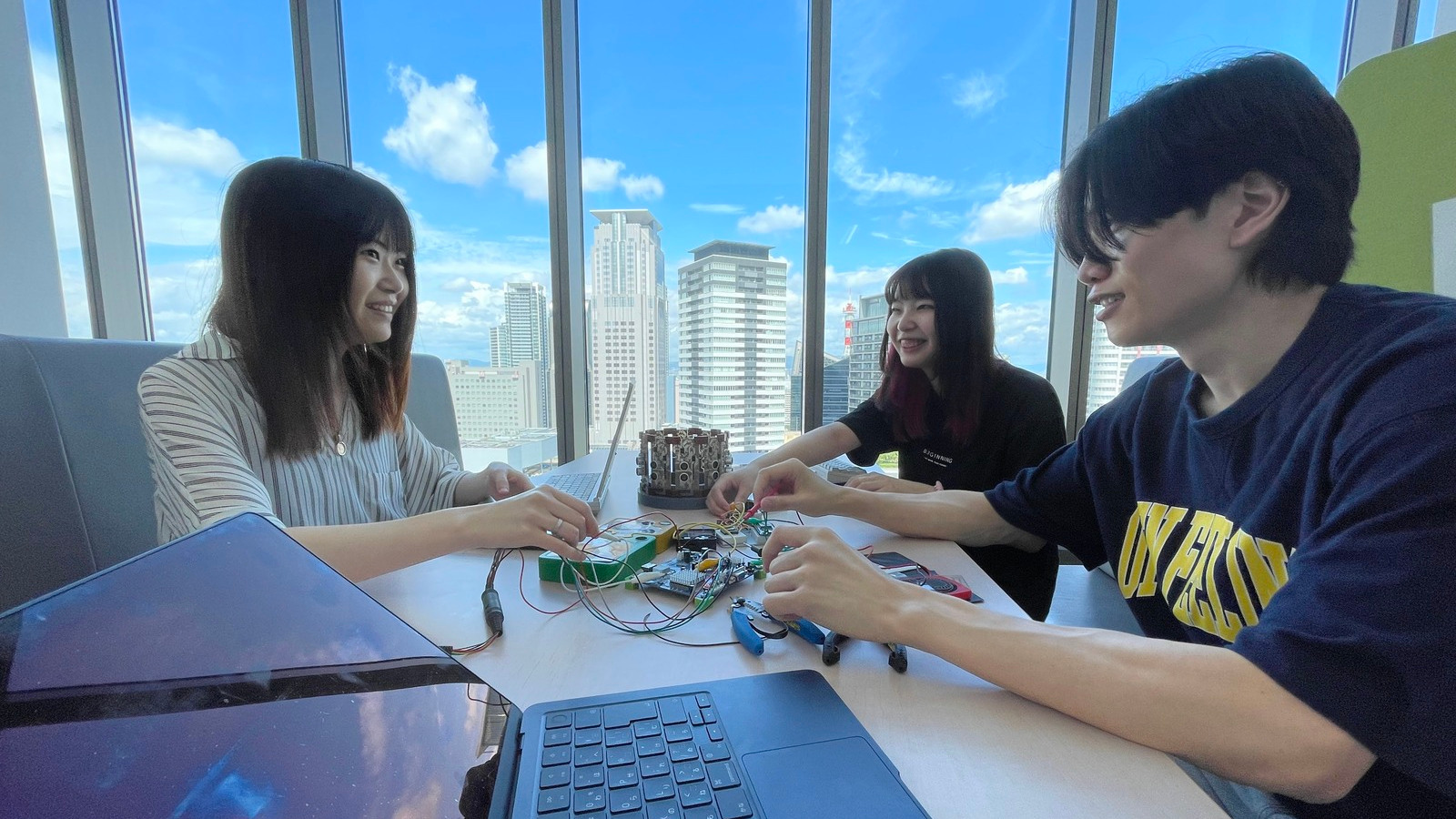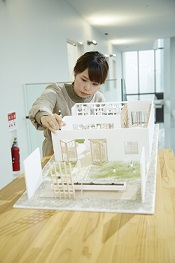Researchers in Graduate School and Faculty of Robotics and Design (AY2024)
Department of Robotics
Education and research on the synthesis of noble robots

Students in this department acquire knowledge and skills of fundamentals and future of robotics. We focus education and research on these engineering and scientific subjects: mechanical engineering; electronics; control engineering; information engineering; neuroscience; brain machine interfaces and biomedical engineering. Our department aims to develop versatile engineers, creative scientists who can contribute to research and development, or production related to mechanical engineering, electronics, industrial robots, home robots, and other related fields.
Point of learning
Practical Training Teaching the Enjoyment Involved in Manufacturing
State-of-the-Art Studies Integrating Technology and Design
Challenging Research in Robotics Across a Broad Spectrum of Themes
| Name (LAST NAME, First Name) * Click Name for Details |
Title | Research Field | Related Info. |
| INOUE, Yuki | P | Measurement engineering, Control engineering/System engineering, Medical systems, Perceptual information processing | Lab |
| KAWAI, Toshikazu | P | Intelligent mechanics/Mechanical systems, Medical systems | Web Lab |
| KURAMAE, Hiroyuki | P※ | Materials / Mechanics of materials | Lab |
| NODA, Akio | P | Intelligent mechanics / Mechanical systems | Web Lab |
| HIROI, Yutaka | P | Robotics | Lab |
| TANIGUCHI, Hironari | P | Biomedical engineering/Biomaterial science and engineering, Rehabilitation science/Welfare engineering, Design engineering/Machine functional elements/Tribology, Intelligent mechanics/Mechanical systems | Lab |
| YOSHIKAWA, Masahiro | P | Rehabilitation science / Welfare engineering | Lab |
| JIANG, Changan | AP | Intelligent mechanics/Mechanical systems, Control engineering/System engineering | Lab |
| KAMANO, Ken | AP | Number Theory | Web |
| HIGASHI, Yoshiyuki | AP | Lab | |
| YOKOYAMA, Kana | ATP | Bilingualism, Heritage Language Education, TESL, History of Japanese Immigrants | Lab |
P = Professor
AP = Associate Professor
ATP = Assistant Professor
※ = Department Chair
Department of System Design

Our department is dedicated to nurture talent capable of creating comprehensive systems that bridge the gap between humans and robots, focusing on the user's perspective. Our program offers students the opportunity to gain a comprehensive understanding of design principles across a range of disciplines?including electronics and electrical engineering, mechanical engineering, and information engineering?through practical work and experimentation. With these skills, our students are prepared to lead research efforts aimed at innovating in areas such as wearable technology and devices that enhance quality of life.
Point of learning
Manufacturing Utilizing IoT Technology
Design Concepts: Comprehensive Education in Engineering Centered Around Humanity
Nurturing Active Human Resources Through Links Between Industry and Academia, and Overseas Studies
| Name (LAST NAME, First Name) * Click Name for Details |
Title | Research Field | Related Info. |
| KOBAYASHI, Hiroyuki | P※ | AI/IoT applied systems | Lab |
| WAKITA, Yumi | P | Social systems engineering / Safety system | Lab |
| INOUE, Akira | P★ | Educational technology | Lab |
| NAKAYAMA, Takayuki | P | Intelligent mechanics/Mechanical systems | Lab |
| INOUE, Tsuyoshi | P | Human Sensing Technologies | Lab |
| TORII, Takashi | P | Science education, Particle/Nuclear/Cosmic ray/Astro physics | |
| OHSUGA, Mieko | P | Affective computing based on psychophysiological measurement | Lab |
| NAKAIZUMI, Fumitaka | AP | Human interface and interaction | Lab |
| YOKOYAMA, Hiromitsu | AP | Environmental Design, Town planning / Architectural planning | Lab |
| SEO, Masataka | AP | Intelligent informatics | Lab |
| PHOTCHARA, Ratsamee | ATP |
P = Professor
AP = Associate Professor
ATP = Assistant Professor
★ = Dean of Faculty
※ = Department Chair
Department of Design and Architecture

Students in the Department of Design and Architecture acquire knowledge and skills in the field of architecture and design that enable them to successfully perform in a broad range of industries, from product and communication design to design planning and architecture.
Our program offers two courses, as follows;
Our program offers two courses, as follows;
- The Product Design course focuses on developing a wide range of products that define our lifestyles, including furniture, lighting, and industrial products that fulfill all human needs and help to create better living environments.
- The Architecture and Interior Design course focuses on developing the architectural design of buildings, including residential and commercial facilities (such as housing and stores), and educational and cultural facilities (such as museums and concert halls), to make useful contributions to our society.
Point of Learning
Educational Program Providing Two Courses in Alignment with Future Ambitions Targeting Future Architects
Space Design Course: Providing the Sensitivity and Technology to Decorate a Wide Range of Different Spaces
Product Design: Cultivating Design Skills that Respect the Sense of Values Inherent with Viewers and Users
| Name (LAST NAME, First Name) * Click Name for Details |
Title | Research Field | Related Info. |
| FUKUHARA, Kazunori | P | Architectural history/Design | Lab |
| IMAI, Miki | P | Study of Visual Design, Editorial Design, Graphical Branding, Exhibition Planning, and History of Design | Lab |
| KORI, Yumi | P | Town planning/Architectural planning | Lab |
| NISHIO, Kouji | P | Town planning / Architectural planning | Lab |
| SHIRAGA, Seiichi | P※ | Design science, Building structures / Materials | Lab |
| MASUOKA, Ryo | P | Design science | Lab |
| TSUMAKI, Noritsugu | AP | Historical studies in general, Architectural history / Design | Lab |
| AKAI, Ai | AP | Kansei informatics, Product Design | Lab |
| MURAO, Junko | AP | Literature in English, Foreign language education | Lab |
| YAMAMOTO, Asako | AP | Architectural history, Design | Lab |
| MIURA, Shinji | ATP | Prototyping and design method for industrial products | Lab |
| KITAWAKI, Reo | ATP |
P = Professor
AP = Associate Professor
ATP = Assistant Professor
※ = Department Chair
Faculty of Robotics and Design
| Name (LAST NAME, First Name) * Click Name for Details |
Title | Research Field | Related Info. |
| KURATA, Koki | ATP | ||
| YOKOGAWA, Keiichi | ATP | Mathematical physics / Fundamental condensed matter physics |
ATP = Assistant Professor / Engineer






